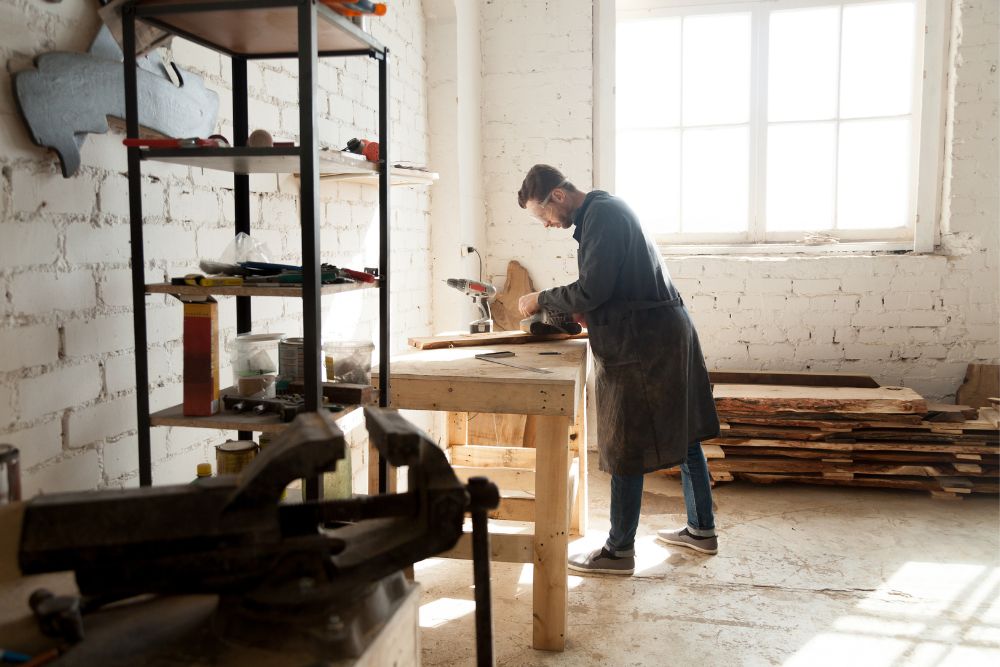Crafting Excellence : Solutions de menuiserie à Bruxelles
- Menuiserie Bruxelles
Maîtriser l’artisanat : services de menuiserie au cœur de Bruxelles
Découvrez un savoir-faire inégalé avec Menuisier Bruxelles, votre première destination pour des solutions de menuiserie exquises à Bruxelles, en Belgique. Nichés au cœur de la ville, nous nous spécialisons dans la transformation d’espaces grâce à nos services de menuiserie méticuleux. Des meubles sur mesure aux boiseries complexes, nos artisans qualifiés donnent vie à vos visions avec précision et passion. Élevez votre maison ou votre entreprise grâce à notre expertise en ramonage de cheminée à Bruxelles, garantissant à la fois fonctionnalité et esthétique. Avec un engagement envers l’excellence et un souci du détail, Menuisier Bruxelles est votre partenaire de confiance dans la création d’espaces exceptionnels qui résistent à l’épreuve du temps.
- À propos de nous
Notre approche
Prêt à rehausser votre espace avec un savoir-faire inégalé ? Ne cherchez pas plus loin que Menuisier Bruxelles, votre première destination pour des solutions de menuiserie exquises à Bruxelles, en Belgique. Notre approche est ancrée dans un engagement envers l’excellence et une passion pour la précision. Que vous recherchiez des meubles sur mesure, des boiseries complexes ou des services de ramonage de cheminée à Bruxelles, nos artisans qualifiés se consacrent à donner vie à votre vision. Nous comprenons que chaque projet est unique, c’est pourquoi nous prenons le temps d’écouter vos besoins et d’adapter nos services en conséquence. De la conception à la réalisation, vous pouvez faire confiance à Menuisier Bruxelles pour vous fournir des résultats exceptionnels qui dépassent vos attentes. Contactez-nous dès aujourd’hui pour discuter de votre projet et découvrir comment nous pouvons transformer votre espace grâce à notre savoir-faire inégalé et notre souci du détail.
- Nos services
Menuiserie Bruxelles Services

Menuiserie intérieure
Il s'agit des travaux de menuiserie effectués dans les espaces intérieurs d'un bâtiment ou d'une structure. Cela comprend des tâches telles que l'installation de portes, de fenêtres, de travaux de boiserie (comme les plinthes, les moulures et les lambris), la construction et l'installation d'escaliers, la charpente de murs et d'autres boiseries décoratives ou fonctionnelles à l'intérieur d'un bâtiment. La menuiserie intérieure se concentre sur l’amélioration de l’esthétique et de la fonctionnalité des espaces intérieurs.

Menuiserie extérieure
La menuiserie extérieure consiste à travailler sur des structures et des éléments à l'extérieur des bâtiments. Cela peut inclure des tâches telles que la construction de terrasses, de clôtures, de pergolas, de belvédères et d'autres structures extérieures. Cela implique également l'installation de boiseries extérieures, de parements, de soffites, de façades et d'autres éléments qui protègent et embellissent l'extérieur d'un bâtiment. La menuiserie extérieure nécessite des matériaux et des techniques capables de résister aux éléments extérieurs tels que les intempéries et l’humidité.

Ébénisterie
L'ébénisterie est une forme spécialisée de menuiserie axée sur la conception, la construction et l'installation d'armoires, d'étagères et d'unités de stockage. Les ébénistes utilisent une variété de matériaux, notamment le bois, le contreplaqué et le MDF (panneaux de fibres de densité moyenne), pour créer des solutions de rangement personnalisées pour les cuisines, les salles de bains, les bureaux et d'autres espaces. L'ébénisterie nécessite précision et attention aux détails pour créer des armoires fonctionnelles et visuellement attrayantes qui répondent aux besoins et préférences spécifiques des clients.

Spécialités
Cette catégorie englobe les services de menuiserie spécialisés ou de nature unique. Cela peut inclure des tâches telles que le travail du bois sur mesure, la sculpture sur bois complexe, la restauration de meubles anciens ou d'éléments architecturaux et d'autres travaux de menuiserie spécialisés. Les spécialités en menuiserie nécessitent souvent des compétences avancées, de la créativité et un savoir-faire pour livrer des pièces uniques ou pour s'attaquer à des projets difficiles qui vont au-delà des tâches typiques de menuiserie.
- Pourquoi nous choisir
Pourquoi choisir la Menuiserie Bruxelles
Avec Menuiserie Bruxelles, vous bénéficiez de notre vaste expertise tant en matière de prestations de menuiserie que de ramonage de cheminée. Nos artisans qualifiés sont des professionnels formés qui comprennent les subtilités du travail du bois et de l’entretien des cheminées, garantissant ainsi des résultats de premier ordre pour chaque projet.
Que vous ayez besoin de travaux de menuiserie sur mesure ou de services de ramonage de cheminée, nous proposons des solutions sur mesure pour répondre à vos besoins spécifiques. De la consultation initiale à l’achèvement du projet, nous accordons la priorité à la compréhension de vos besoins et à la fourniture de solutions personnalisées qui dépassent vos attentes.
Chez Menuisier Bruxelles, la qualité et la précision sont au premier plan de tout ce que nous faisons. Nous sommes fiers de notre savoir-faire méticuleux et de notre attention aux détails, garantissant que chaque aspect de votre projet est réalisé selon les normes d’excellence les plus élevées.
En tant qu'entreprise détenue et exploitée localement à Bruxelles, en Belgique, nous avons une compréhension approfondie des styles architecturaux uniques, des codes de construction et des facteurs environnementaux spécifiques à la région. Cette expertise locale nous permet d’offrir des services de menuiserie et de ramonage de cheminée de qualité supérieure adaptés aux besoins de notre communauté.
Votre satisfaction est notre priorité absolue chez Menuiserie Bruxelles. Depuis votre prise de contact jusqu'à l'inspection finale, nous nous efforçons de faire en sorte que vous soyez entièrement satisfait des résultats de notre travail. Avec un engagement envers le professionnalisme, la fiabilité et un service exceptionnel, choisir Menuisier Bruxelles, c'est choisir la tranquillité d'esprit pour vos besoins de menuiserie et de ramonage de cheminée.
- Notre processus
Comment nous procédons
- Témoignages
Ce que disent nos clients à propos de Menuiserie Bruxelles
"I couldn't be happier with the carpentry work done by Menuisier Bruxelles. From the initial consultation to the final installation, their team was professional, courteous, and attentive to detail. They transformed my space in Bruxelles with beautifully crafted custom furniture and trim work, exceeding my expectations. I highly recommend Menuisier Bruxelles for anyone looking for top-notch carpentry services in the area."

"Menuisier Bruxelles is simply exceptional. Their expertise in both carpentry and chimney sweeping made them the perfect choice for our home renovation project in Bruxelles. Not only did they deliver impeccable craftsmanship, but they also provided invaluable insights and recommendations that enhanced the overall design. It's rare to find such dedication to quality and customer satisfaction. I wouldn't hesitate to hire Menuisier Bruxelles again."

"Working with Menuisier Bruxelles was a seamless and enjoyable experience from start to finish. Their team's professionalism, expertise, and attention to detail were evident throughout the entire process. They transformed our outdated space in Bruxelles into a modern, stylish environment that exceeded our expectations. I'm grateful for their commitment to excellence and wouldn't hesitate to recommend Menuisier Bruxelles to anyone seeking superior carpentry services."

- Foire aux questions
Vous avez des questions ? Nous sommes ici pour aider.
Menuiserie Bruxelles propose une large gamme de services comprenant la menuiserie intérieure et extérieure, la conception et l'installation de meubles sur mesure, l'ébénisterie, le ramonage de cheminée à Bruxelles, etc.
Pour demander un devis, contactez-nous simplement via notre site Internet ou appelez-nous. Nous planifierons une consultation pour discuter des exigences de votre projet et vous fournirons une estimation détaillée basée sur vos besoins.
Oui, notre équipe d’artisans qualifiés peut vous accompagner dans la phase de conception de votre projet. Nous travaillerons en étroite collaboration avec vous pour comprendre votre vision et vos préférences, et vous fournirons des recommandations pour vous aider à donner vie à vos idées.
Oui, Menuisier Bruxelles s'adresse à la fois aux clients résidentiels et commerciaux à Bruxelles, en Belgique. Que vous ayez besoin de travaux de menuiserie pour votre maison, votre bureau, votre espace commercial ou toute autre propriété commerciale, nous sommes là pour vous aider.
La durée d'un projet de menuiserie varie en fonction de l'ampleur et de la complexité des travaux impliqués. Lors de la première consultation, nous vous fournirons un calendrier de votre projet en fonction de ses exigences spécifiques.
Oui, nous garantissons la qualité de notre travail et offrons des garanties sur nos services de menuiserie. Si vous rencontrez des problèmes après l'achèvement de votre projet, contactez-nous simplement et nous les résoudrons dans les plus brefs délais.
- Entrez en contact
Contactez-nous
En conclusion, Menuisier Bruxelles se présente comme votre première destination pour des solutions de menuiserie exceptionnelles à Bruxelles, en Belgique. Avec un engagement envers l’artisanat, la précision et la satisfaction du client, nous transformons les espaces grâce à notre expertise en matière de services de menuiserie et de ramonage de cheminée à Bruxelles. Des meubles sur mesure aux boiseries complexes, nos artisans qualifiés donnent vie à votre vision avec une attention méticuleuse aux détails. Faites-nous confiance pour rehausser votre maison ou votre entreprise avec des solutions sur mesure qui reflètent votre style et améliorent la fonctionnalité. Prêt à vous lancer dans votre prochain projet de menuiserie ? Contactez-nous aujourd’hui au +32460234333 pour planifier une consultation et découvrir comment Menuisier Bruxelles peut concrétiser votre vision.

